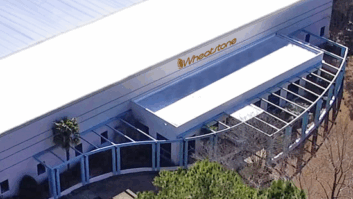Jack Roland is based in Denver and is a field engineer for EMF’s K-LOVE/Air1 stations. Jack also writes “The KE0VH Hamshack” article on the Society of Broadcast Engineers Chapter 48 page.
After reviewing some commercial offerings for tilting his DX Engineering ham radio 5 BTV vertical antenna, which were all pretty pricey, Jack came up with the concept seen in Fig. 1. Jack then came up with what he calls his “lazy Susan” experimental rig.

Using a couple of pieces of zinc-coated angle iron cut from a piece purchased at Home Depot, seen in Fig. 2, Jack added some self-tapping screws to provide a sturdy-yet-inexpensive mount for a vertical antenna.

In this photo, you can see the wingnuts to release and move the antenna.
Fig. 3 shows Jack’s friend Harold Hallikainen (W6IWI) holding the antenna mast as it tilts in one direction.

Fig. 4 shows the mast tilted in the other direction. The concept is more versatile than anything Jack has seen commercially, is inexpensive to construct and should withstand the 70 mph winds that they sometimes get in Denver.

Since the mast can be lowered, I’m wondering how such a mast could be used in hurricane country. Share your thoughts and your own inventions.
If you are buying Ethernet cable or “IT widgets,” you know their cost can nickel and dime you to death. Workbench reader, project consultant and frequent contributor Dan Slentz passes on a great website that an equipment dealer told him about.
The company is found at www.Monoprice.com. You’ll find that the prices are good, so you’ll save money, and the company even offers a lifetime guarantee on their cables.
In addition to Ethernet cables and adaptors, the company sells products for HDMI, USB and video/audio/switching applications. They even sell printer toner!
New Hampshire Public Radio’s Stephanie Donnell writes that on the recommendation of the station’s generator service technician, she added some coarse (1/2-inch square) screening over the openings for one of NHPR’s generators. She thought about using some finer (1/4-inch square) screen, but was concerned about restricting air flow.
Seen in Fig. 5, the larger screen may not keep all of the smallest critters out, such as mice, but it should prevent larger rodents from getting in. The purpose is to prevent what Stephanie has come to call “exploding squirrels.” Fan belts and squirrels don’t mix.

Stephanie may add another layer of screen along the lower quarter, and interleave it with the first layer, so as to effectively reduce the aperture of those openings further.
Broadcast Veteran Lou Schneider retired last year as the “transmitter guy” for KCRW’s six full-power FMs stretching from San Luis Obispo to Indio/Palm Springs, Calif. — not to mention eight translators covering the high desert areas.
Spending so much time with transmitter sites, Lou knows remote control temperature monitoring, and he’s also used Texas Instruments’ LM34 Precision Fahrenheit Temperature Sensor to measure site air temperatures. This compact TO-92 package is a three-lead device that directly outputs 10 mV per degree F.
As long as your ambient temperature is above 5 degrees F, just connect it to a source of between +5 volts to +30 volts, and feed the Output and Ground leads to the input of your remote control system, and you’re done. Lou has used Belden 8451, two conductor plus shield, cable and it works fine. Use the shield conductor as ground, red for the +V to the LM34 and black for the output return.
Lou also places a piece of heat shrink over the LM34 to insulate the lead connections, and after which, you’re done.
Contribute to Workbench. You’ll help fellow engineers and qualify for SBE recertification credit. Send Workbench tips and high-resolution photos to [email protected].







